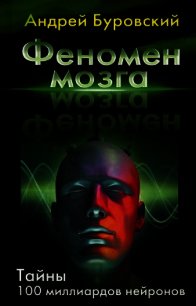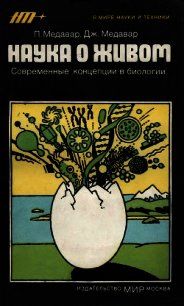Генеалогия нейронов - Сахаров Дмитрий Антонович (книга бесплатный формат .TXT) 📗
280. Sakharov D. A. 1972. Electrophysiological study of factors controlling the activity of molluscan neurosecretory cells. — Gen. Compar. Endocrinol., 18, 621 — 622 (an abstract).Sakharov D. A. 1974. Evolutionary aspects of transmitter heterogeneity. J. Neural Transmission, Suppl. 11, 43 — 59.
281. Sakharov D. A., Borovyagin V. L., Zs.-Nagy I. 1965. Light, fluorescence and electron microscopic studies on «neurosecretion» in Tritonia diomedia Bergh (Mollusca, Nudibranchia). — Z. Zellforsch., 68, 660 — 673.
282. Sakharov D. A., Salánki J. 1969. Physiological and pharmacological identification of neurons in the central nervous system of Helix pomatia L. Acta physiol. hung., 35, 19 — 30.
283. Sakharov D. A., Salánki J. 1971. Study of neurosecretory cells of Helix pomatia by intracellular dye injection. — Expenentia, 27, 655 — 656.
284. Sakharov D. A., Turpajev T. M. 1968. Evolution of cholinergic transmission. — In «Neurobiology of invertebrates». Budapest, Akad. Kiado, p. 305 — 314.
285. Sakharov D. A., Zs.-Nagy I. 1968. Localization of biogenic monoamines in cerebral ganglia of Lymnaea stagnalis. — Acta biol. hung., 19, 145 — 157.
286. Sakharova A. V., Sakharov D. A. 1971. Visualization of intraneuronal monoamines by treatment with formalin solutions. — Progr. Brain Res., 34,11 — 26.
287. Salánki J. 1968. Studies on the effect of iontophoretically applied 1-glutamate on the giant nerve cells of gastropode (Helix and Limnaea). — Annal Biol. Tihany, 35, 75 — 81.
288. Salánki J., Vadász I., Elekes K. 1972. Physiological and morphological characteristics of Br-type neuron in the central nervous system of the snail Helix pomatia L. — Acta physiol. hung., 42, 243 — 254.
289. Salánki J., Kiss I. 1969. Identified cells in the central nervous system of Lymnaea stagnalis L. — Annal. Biol. Tihany, 36, 63 — 75.
290. Schon F., Iversen L. L. 1972. Selective accumulation of 3H-GABA by stellate cells in rat cerebellar cortex in vivo. — Brain Res., 42, 503 — 507.
291. Sedden С. В., Walker R. J., Kerkut G. A. 1968. The localization of dopamine and 5-hydroxytryptamine in neurones of Helix aspersa. — Sympos. Zool. Soc. London, № 22, 19 — 32.
292. Sheard M. H., Zolovick A. J. 1971. Serotonin: Release in cat brain and cerebrospinal fluid on stimulation of midbrain raphe. — Brain Res., 26, 455 — 458.
293. Sherman R. G., Atwood H. L. 1972. Correlated electrophysiological and ultrastructural studies of a crustacean motor unit. — J. Gen. Physiol., 59, 586 — 615. 294. Smith A. D. 1971. Summing up: Some implications of the neuron as a secreting cell. — Philos. Trans. Roy. Soc. London, B261, 423 — 437.
295. Smith U. 1970. The origin of small vesicles in neurosecretory axons. — Tissue and Cell, 2, 427 — 433.
296. Sneddon J. D., Smythe A., Satchell D., Burnstock G. 1973. An investigation of the identily of the transmitter substance released by non-adrenergic, non-cholinergic excitatory nerves supplying the small intestine of some lower vertebrates. — Compar. Gen. Pharmacol., 4, 53 — 60.
297. S.-Rózsa K., Perényi L. 1966. Chemical identification of the excitatory substance released in Helix heart during stimulation of the extracardial nerve. — Compar. Biochem. Physiol., 19, 105 — 113.
298a. S.-Rózsa K., Salánki J. 1973. Responses of central neurones to the stimulation of heart chemoreceptors in the snail, Helix pomatia L. — Annal. Bio Tihany, 40, 95 — 108.
298б. S.-Rózsa K., Salánki J. 1973. Single neurone responses to tactile stimulation of the heart in the snail. Helix pomatia L. — J. Compar. Physiol., 84, 267 — 279.
299. Stinnakre J., Tauc L. 1973. Calcium influx in active Aplysia neurones detected by injected aequorin.- Nature New Biol., 242, 113 — 115.
300. Stroch V. 1971. Biogene Amine in Rezeptororganen von Gastropoden (Prosobranchia, Opisthobranchia). — Z. Zellforsch., 115, 94 — 99.
301. Strumwasser F. 1962. Post-synaptic inhibition and excitation produced by different branches of a single neuron and the common transmitter involved. — Excerpta Med., Internat. Congress Series, № 48, 801 (an abstract).
302.Strumwasser F. 1971. The cellular basis of behaviour in Aplysia. — J. Psychiat. Res., 8, 237 — 257.
303. Suburo A. M., Pellegrino de Iraldi A. 1969. An ultrastructural study of the rat's suprachiasmatic nucleus. — J. Anat., 105, 439 — 446.
304 Szczepaniak A. C, Cottrell G. A. 1973. Biphasic action of glutamic acid and synaptic inhibition in an identified serotonin-containing neurone. — Nature New Biol., 241,62 — 64.
305. Tauc L. 1966. Physiology of the nervous system. — In «Physiology of Mollusca», vol. 2. N. Y., Acad. Press, p. 387 — 454.
306. Tauc L. 1967. Transmission in invertebrate and vertebrate ganglia. — Physiol. Revs, 47, 521 — 593.
307. Tauc L. 1969. Polyphasic synaptic activity. — Progr. Brain Res., 31, 247 — 2 57.
308. Tauc L., Gerschenfeld H. M. 1961. Cholinergic transmission mechanisms for both excitation and inhibition in molluscan central synapses. — Nature, 192, 366 — 367.
309. Tauc L., Gerschenfeld H. M. 1962. A cholinergic mechanism of inhibitory synaptic transmission in a molluscan nervous system. — J. Neurophysiol., 25, 236 — 262.
310. Tauc L., Hughes G. M. 1963. Modes of inhibition and propagation of spikes in the branching axons of molluscan central neurons. — J. Gen. Physiol., 46, 533 — 549.
311. Taylor K. M., Snyder S. H. 1973. The release of histamine from tissue slices of rat hypothalamus. — J. Neurochem., 21, 1215 — 1223.
312. Tebecis A. K., DiMaria A. 1972. Strichnine-sensitive inhibition in the medullary reticular formation: Evidence for glycine as an inhibitory transmitter. — Brain Res., 40, 373 — 383.
313. Thoenen H., Tranzer J. P. 1973. The pharmacology of 6-hydroxydopamine. — Annual Rev. Pharmacol., 13, 169 — 180.
314. Thureson-Klein Å., Klein R. L., Yen S.-S. 1973. Ultrastructure of highly purified sympathetic nerve vesicles: Correlation between matrix density and norepinephrine content. — J. Ultrastr. Res., 43, 18 — 35.
315. Toevs L. A., Brackenbury R. W. 1969. Bag cell-specific proteins and the humoral control of egg laying in Aplysia californica. — Compar. Biochem. Physiol., 29, 207 — 216.
316. Tranzer J. P., Thoenen H. 1967. Significance of empty vesicles in postganglionic sympathetic nerve terminals. — Experientia, 23, 123 — 124.
317. Turpaev T. M., Sakharov D. A. 1973. Comparative physiology of the mechanisms terminating the synaptic action of acetylcholine. — In «Comparative pharmacology», vol. 1. Oxford, Pergamon Press, p. 345 — 355.
318. Uchizono K. 1965. Characteristics of excitatory and inhibitory synapses in the central nervous system of the cat. — Nature, 205, 642 — 643.
319. Ungerstedt U. 1971. Stereotaxic mapping of the monoamine pathways in the rat brain. — Acta physiol. scand., Suppl. 367, part 1.
320. Usherwood P. N. R. 1972. Glutamate as an excitatory neuromuscular transmitter in insects. — Neurosci. Res. Progr. Bull., 10, 136 — 143.
321. Van Mol J.-J. 1967. Etude morphologique et phylogénétique du ganglion cérébroide des Gastéropodes Pulmonés (Mollusques). — Mém. Acad. roy. Belgique Cl. sci., 37, 1 — 168.
322. Vogt M. 1954. The concentration of sympathin in different parts of the central nervous system under normal conditions and after administration of drugs. — J. Physiol., 123, 451 — 481.
323. Vollrath L. 1969. Über die Herkunft «synaptischer» Bläschen in neurosekretorischen Axonen. — Z. Zellforsch., 99, 146 — 152.




